 Cavs Archive
Cavs Archive  Blast From The Past: Cleveland. 1962. Steinbrenner. NBA?
Blast From The Past: Cleveland. 1962. Steinbrenner. NBA?
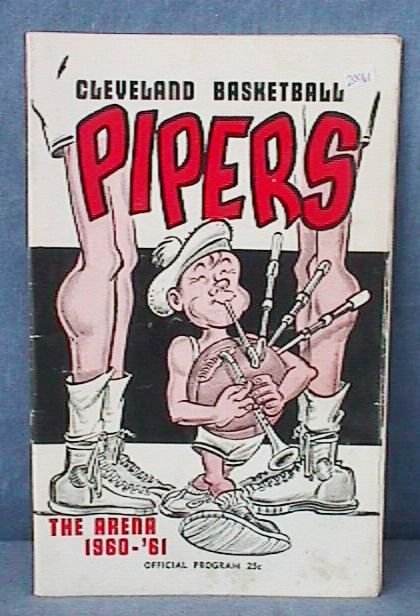 Last week, we recalled the birth of the Cleveland Cavaliers. Unlike me, you may have known that Cleveland was thisclose to joining the NBA almost ten years earlier. And would have been good.
Last week, we recalled the birth of the Cleveland Cavaliers. Unlike me, you may have known that Cleveland was thisclose to joining the NBA almost ten years earlier. And would have been good.
By the end of the 1950s, the National Industrial Basketball League had been in operation for over ten seasons. Originally formed as a league for mill workers, the teams of the NIBL were largely corporately sponsored. There were the Akron Goodyear Wingfoots. The Seattle Buchan Bakers. The dominant team among the six- to eight- team semi-pro league was the Bartlesville Phillips 66ers. Ohio was represented by the Cleveland Sweeny Pipers, headed by plumbing company owner Ed Sweeny.
Mr. Sweeny was struggling financially by 1961. Abe Saperstein was rounding up a group of investors who would run a league that would rival the National Basketball Association. Saperstein had supported the NBA with doubleheader games against his Harlem Globetrotters- only to be snubbed when the league began operations in Los Angeles.
The Globetrotters were actually from Chicago, and were given the name “Harlem” to indicate that the players were black. The original name of the Globetrotters was the Savoy Big Five.
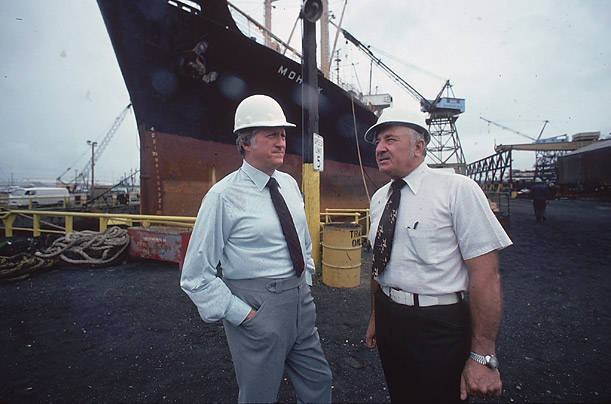 Saperstein and his fellow owners formed a new league from the ruins of the NIBL: the American Basketball League. The Sweeny Pipers were purchased by George Steinbrenner. The 31 year old Cleveland businessman was working for his father’s shipbuilding company (Kinsman Marine Transit), based in the Rockefeller Building at Superior Avenue and West Sixth Street.
Saperstein and his fellow owners formed a new league from the ruins of the NIBL: the American Basketball League. The Sweeny Pipers were purchased by George Steinbrenner. The 31 year old Cleveland businessman was working for his father’s shipbuilding company (Kinsman Marine Transit), based in the Rockefeller Building at Superior Avenue and West Sixth Street.
On the first day of the 1961-62 season, George Steinbrenner sold a player to the Hawaiian Chiefs. During the game, at halftime. He told the player to turn in his uniform and suit up for the Chiefs- he thought it made sense to save on travel expenses. Coach John McLendon took the player aside and asked him to go have a seat in the stands.
You think George was a walking time bomb? By all accounts, the elder Steinbrenner was every bit the bombastic, strong-willed patriarch who dominated his associates in the way sports fans would eventually come to expect from George. In fact, Henry’s short fuse applied particularly to his relationship with his son. Office visitors were expected to wait until after 5:00pm before they were allowed to visit with George to discuss his basketball endeavors. George also had a dedicated telephone installed in his office, equipped without a bell. It flashed a red light for incoming calls- lest Henry would be alerted to his son’s conducting personal business on company time (the phone could be stowed in a drawer when George was away). And Henry refused to help George to fund his sports initiatives.
The ABL would only last a year and a half, but it was noteworthy for several reasons:
- The current, U.S,, ‘widened’ free-throw lane began there.
- The three-point shot originated in the ABL. The brainchild of Saperstein, it was originally termed the ‘home run shot’ and was roughly two feet further out than the current NBA arc. It soon was moved to roughly where the NBA arc is today.
- John McLendon was the first black professional sports head coach in the United States. (Steinbrenner was not enamored with the coach, and wanted a bigger name.)
- McLendon’s philosophy favored the up-tempo, fast-break style of play. He was in the process of revolutionizing the sport, and his short time with the Pipers was just part of his 25+ year coaching career (which included stints with Cleveland State University and the ABA’s Denver Rockets).
 Interestingly, John McLendon studied basketball under the inventor of the game, James Naismith (photo), while on the staff at the University of Kansas- where he was unable to play due to their restriction on players to only those who were racially white.
Interestingly, John McLendon studied basketball under the inventor of the game, James Naismith (photo), while on the staff at the University of Kansas- where he was unable to play due to their restriction on players to only those who were racially white.
Steinbrenner’s Pipers were the top team of the ABL in 1961-62. The most prominent player on that team was future New York Knick star- and former NBA Syracuse National standout- Dick Barnett. Not surprisingly, the owner was known to vocalize his opinions and objections to the way the team was run. He sat behind the Pipers' bench and second-guessed his coach (Steinbrenner had acquired players of some renown- but they didn’t fit McLendon’s running style and George would boil as they sat during games). The owner also had no qualms about running to the court and arguing with officials.
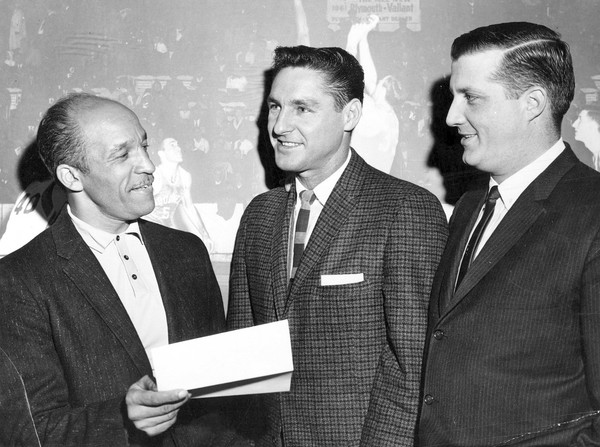 McLendon grew tired of Steinbrenner’s heavy hand and either quit, or was fired, right in the middle of their successful season. What rings true is that the owner was fine with him remaining with the team, but felt he had to be removed as coach. A huge factor was the sudden availability of former Boston Celtic Bill Sharman- Sharman had been coach of Abe Saperstein’s Los Angeles Jets, which had folded. Steinbrenner signed Sharman as his new coach. (See photo, which portrays McLendon, Sharman and Steinbrenner in a harmonious moment.)
McLendon grew tired of Steinbrenner’s heavy hand and either quit, or was fired, right in the middle of their successful season. What rings true is that the owner was fine with him remaining with the team, but felt he had to be removed as coach. A huge factor was the sudden availability of former Boston Celtic Bill Sharman- Sharman had been coach of Abe Saperstein’s Los Angeles Jets, which had folded. Steinbrenner signed Sharman as his new coach. (See photo, which portrays McLendon, Sharman and Steinbrenner in a harmonious moment.)
Undeniably, Bill Sharman was very effective as the Pipers’ coach in 1962. Perhaps coincidentally, he occasionally locked the doors at their practice gym to keep the owner out. A staple of Sharman’s was the shootaround, which had not previously been a sanctioned form of practice. Routine in the present day at all levels of basketball, some of Sharman’s players fifty years ago were concerned that the unstructured shooting and rebounding among several players at one time would result in their being tired or stiff come game time (wow).
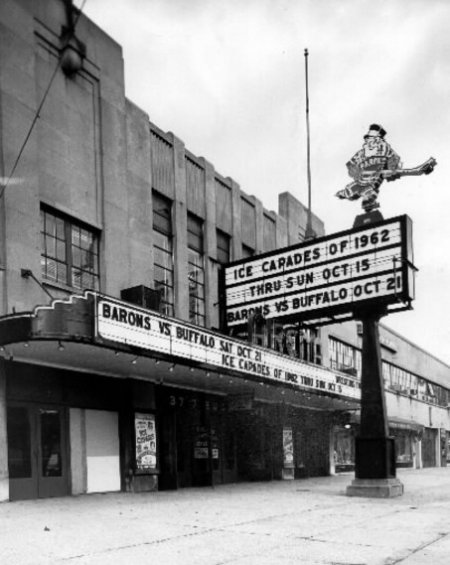 The Pipers played most of their home games at the Cleveland Arena (photo), although at least one game was held at Public Hall. After losing the first two games of the league championship series, the 1961-62 team won the league title over the Kansas City Steers, 3 games to 2.
The Pipers played most of their home games at the Cleveland Arena (photo), although at least one game was held at Public Hall. After losing the first two games of the league championship series, the 1961-62 team won the league title over the Kansas City Steers, 3 games to 2.
The general manager of the Steers had been the Pipers’ GM until several months earlier. Mike Cleary was fired prior to the season in an explosive fit of rage by George Steinbrenner. The owner had just signed Dick Barnett, and had an arrangement lined up with The Cleveland Press to make a splash with a feature story. Some say that night may have been the first night in Cleveland for television broadcaster (and future Browns radio announcer) Gib Shanley- he had just arrived from Toledo. Shanley caught wind of the Barnett signing, and innocently enough, mentioned it on his sports broadcast during the evening news. In response, The Plain Dealer ran a short item the next morning’s paper. By then the signing was old news. The afternoon paper, The Cleveland Press, made brief mention of the signing - there was no coup for Steinbrenner’s big news. He was livid. Cleary had to go, through no real fault of his own. But Cleary eventually retaliated, when the Pipers made a visit to Kansas City. In town for a three game series during the regular season (such series were common, to drum up interest. Cleary has commented that game one might feature a fight, and attendance would improve over the next couple games!), Cleary sent Steinbrenner his ticket proceeds- which amounted to pocket change. He enclosed a letter, explaining that he was sure Steinbrenner simply had forgotten to pay Cleary for his last two weeks with the Pipers- and since George was such a magnanimous guy, Cleary felt certain the owner had meant to pay him two weeks’ severance as well! Steinbrenner immediately called Cleary and had a big laugh.
To the surprise of nobody who is aware of George Steinbrenner’s later ownership of baseball’s New York Yankees, he was just getting started. His intention was to join the NBA. Dick Barnett decided to jump back over to the senior league due to the ABL’s subpar salaries, living conditions, and overall instability. And Bill Sharman was going to be tough to continue to afford. But the owner had a plan: sign Ohio State University star, Jerry Lucas.
Lucas was the standout who had led OSU to consecutive college basketball title games versus the University of Cincinnati. He had already been previously drafted by the NBA’s Cincinnati Royals, who were waiting for him to graduate.
The Royals featured University of Cincinnati star Oscar Robertson, considered by some the best basketball player ever until Michael Jordan came along. Their center was future Cleveland Cavalier GM Wayne Embry.
In the 1950s, Lucas had already drawn 10,000 to Cleveland Arena as a high school star. By 1962, he had completed his undergraduate studies in three years. He did not wish to play professional basketball. The NBA could offer him money, but he had other goals and interests as well. He remained a serious student who intended to enroll in graduate school. He was also married, and did not wish to travel.
Steinbrenner blew Lucas away with a carefully prepared offer. He opened the Pipers’ books to the player, and shared expectations of attendance and revenue should he decide to come to Cleveland. He disclosed that his ownership group had originally purchased the team because they hoped to sign Lucas. The ABL draft had territorial (in-state) picks, and he had insisted each team receive two such picks- it began to be accepted at the time that fellow Ohio State star John Havlicek would eventually join the Pipers as well.
Lucas disclosed in an open letter in Sports Illustrated that Steinbrenner carefully studied his objections to playing professional basketball. The owner then copied the process that Ohio State had employed to win over Lucas four years earlier. Steinbrenner had gotten the ABL season shortened to about 70 games- beginning the season in December in order to accommodate Lucas’ Fall school schedule. He only asked the player for a two year commitment. And instead of simply offering the high salary dangled by the Royals, he had assembled a package of investments that would net a comparably low level of pay- but would remain after Lucas’ playing commitment was completed (additionally, the investments were placed with particular firms that interested Lucas as possible future career opportunities).
Lucas was impressed. The Pipers had concerned themselves with his personal priorities. The travel concerns remained, but this was allayed by Lucas’ realization that he could only remain a role model to children if he continued to play basketball. He took his solid public image seriously, and used it among various public charities and other organizations.
I found a published account of the New York Knicks considering offering the Royals a player and a large amount of cash in return for the rights to sign Lucas. They assumed they could offer him an amount of money that he could not refuse. Huh. Imagine that.
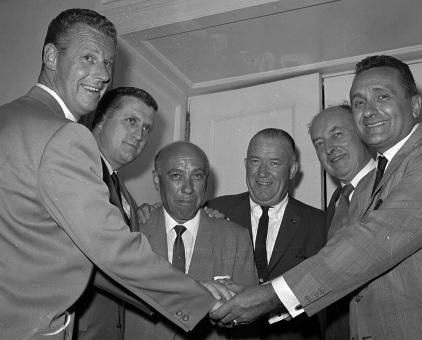 With Jerry Lucas on board, George Steinbrenner received a verbal agreement to have the Pipers join the NBA for the 1962-63 season (photo). That season’s schedule featured an opening game against the Knicks. Cincinnati protested, since they had expected to eventually sign Lucas. Haggling commenced over the Pipers’ entry fee into the Association; accounts differ over the exact amount. But it was large, with much of the total going to the Royals. The Kansas City Steers’ roster would to assimilate into the Cleveland roster- the Pipers were going to hit the ground running in the NBA. However, Steers owner and new Pipers partner George McKean fell behind in his payments to the NBA. George Steinbrenner approached his father for funding and was turned down. The Pipers folded, as did the ABL that following season.
With Jerry Lucas on board, George Steinbrenner received a verbal agreement to have the Pipers join the NBA for the 1962-63 season (photo). That season’s schedule featured an opening game against the Knicks. Cincinnati protested, since they had expected to eventually sign Lucas. Haggling commenced over the Pipers’ entry fee into the Association; accounts differ over the exact amount. But it was large, with much of the total going to the Royals. The Kansas City Steers’ roster would to assimilate into the Cleveland roster- the Pipers were going to hit the ground running in the NBA. However, Steers owner and new Pipers partner George McKean fell behind in his payments to the NBA. George Steinbrenner approached his father for funding and was turned down. The Pipers folded, as did the ABL that following season.
Some accounts hold that Steinbrenner folded the team in a fit of spite in response to the ABL suing him for jumping to the NBA. I do not believe this to be true- I just think he ran out of money. He ended up deeply in the hole- but worked his other business interests toward the payment of his debts until they were paid off. It was a matter of principle.
In 1972, Steinbrenner had a verbal agreement with frozen-food magnate Vernon Stouffer to purchase baseball’s Cleveland Indians. Stouffer backed out of that deal, selling instead to Nick Mileti. Soon after, George Steinbrenner would put together another ownership group and buy the New York Yankees.
Sources for this article included the following: Steinbrenner: The Last Lion of Baseball by Bill Madden, the Sports Illustrated archives, and Dan Coughlin's book Pass the Nuts (but only the autographed version- ha).
Thank you for reading. Here's are some Pipers player photos, pre-Barnett:
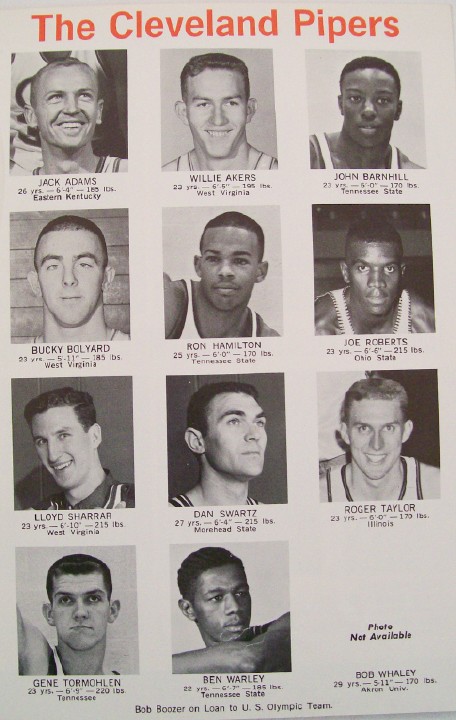
- NBA Announces 2013-2014 Schedule
- Browns Ink Sharknado
- Sharknado A No-Show For Rookie Camp
- Trent Richardson Out Until Training Camp
- Browns Sign Brandon Jackson
- Carrasco Suspended Eight Games
- Browns Add to Wide Receiver Depth with David Nelson
- Browns Need to Learn from Past Draft Mistakes
- Browns Release Chris Gocong and Usama Young
- Browns Missing on Grimes Disappointing, But Not The End
The TCF Forums
- Official- Browns Coach Search/Rumors
mattvan1 (Tuesday, January 21 2014 1:19 PM) - Movies coming out
rebelwithoutaclue (Tuesday, January 21 2014 12:56 PM) - 2015 Recruiting
jclvd_23 (Tuesday, January 21 2014 12:38 PM) - The 2014 Offseason Thread
Larvell Blanks (Tuesday, January 21 2014 12:25 PM) - Chris Grant's first 3 drafts
Kingpin74 (Tuesday, January 21 2014 10:13 AM) - Mike Brown
YahooFanChicago (Monday, January 20 2014 11:15 PM) - 2014 Hoops Hockey Hijinx
jpd1224 (Monday, January 20 2014 4:44 PM) - 2014 Recruiting
jclvd_23 (Monday, January 20 2014 2:26 PM) - Wish List - #4 Pick
Hikohadon (Monday, January 20 2014 1:26 PM) - #1 overall pick Anthony Bennett
TouchEmAllTime (Sunday, January 19 2014 1:28 PM)



